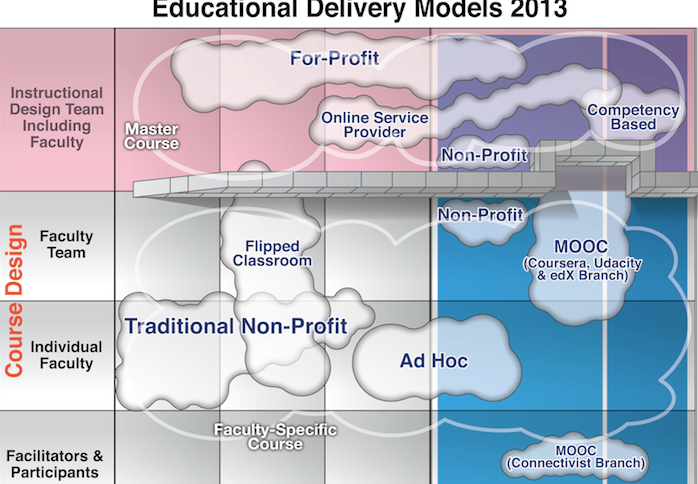As Michael mentioned, we have posted the last episode in the pilot e-Literate TV series with the topic of moving to a team-based course design for a flipped classroom usage. This episode provides an excellent opportunity to hear the first-hand experience of a faculty member going through this transition for the first time. Vanessa Perry of GWU had no real expectations or understanding of what this transition would encompass.
The adoption of team-based course design presents a cultural barrier for traditional institutions, as shown by a wall in the graphic that was the basis for a 2012 EDUCAUSE Review article.
Vanessa describes what this barrier, or wall, feels like as you attempt to cross it, as seen in this snippet from the interview (full transcript and video and graphics available at the full episode on e-Literate TV).
Starting at 2:44, emphasis added.
Phil Hill:
Now, given those changes, which they sound great on paper, but one of the issues that’s very interesting that I’d like to get your thoughts on, is it’s fine to say, “There’s a reason for change,” but then there’s the issue of, “Well, we need to actually go through the change,” particularly for a faculty member where you’re really presenting the material, guiding students.
So, tell me a little bit about the change from your perspective of what you used to teach—how your method used to be of teaching—and then getting into this flipped classroom method, particularly with working with a team for design. How did that change things?
Vanessa Perry:
Well, you’re right, it’s one of those things that does sound good on paper. And so, I’d heard that it was really easy and “All you’ve got to do is take the stuff that you have in your PowerPoints and they’re just going to record it.
It’ll be fine; it will be very much like what you have always done.” Well that is so absolutely not the case. It’s nothing like what we’ve always done.
Traditionally, what I did was I sort of accumulated materials over time. I had my PowerPoint slides, and I would get up, and I would talk.
And I would talk for 60 minutes or 75 minutes or for however long, and I would stop, and I would ask students questions. And it was semi-interactive, but it was pretty much traditional talk, one-way kind of communication.
What I had to do was go back through those materials and figure out: What are the key elements that I’m best at delivering via lecture?
Versus: Now, what are the elements that are probably best delivered some other way? “Let’s put this package together.”
This is a production; it’s not like a class in the way that I had thought about it. And that was a real transformation—a real evolution—but it was certainly not easy at first.
Later on (starting at 6:12) Vanessa describes how she was very skeptical going into the process.
Vanessa Perry:
Oh, I was one of the people running around saying that this online instruction is never really going to work. And I thought it was sort of this low-quality alternative.
And I actually thought of it the same way that I thought about taking driver’s ed refresher courses; I had no real experience so all I could draw on were a couple of anecdotal situations, which were kind of these low-quality kinds of lecture capture, automated voiceover kinds of delivery mechanisms. And so, I was completely skeptical.
And when our school decided that we were going to take this sort of strategic step, I was totally against it.
In Vanessa’s case, eventually she saw the benefits and even applied the new methods to her face-to-face course (starting at 9:32).
Vanessa Perry:
I had to teach a face-to-face course, and I decided to use the digital community version in the face-to-face course, and it went so well. It went far better than, I think, teaching that course face-to-face has ever done before.
Vanessa’s case is but one example of this digital transformation in teaching, but I think her story describes several situations that many faculty members face. It is very useful to hear and understand these issues.
There’s much more to hear in this interview – see the full episode here.
